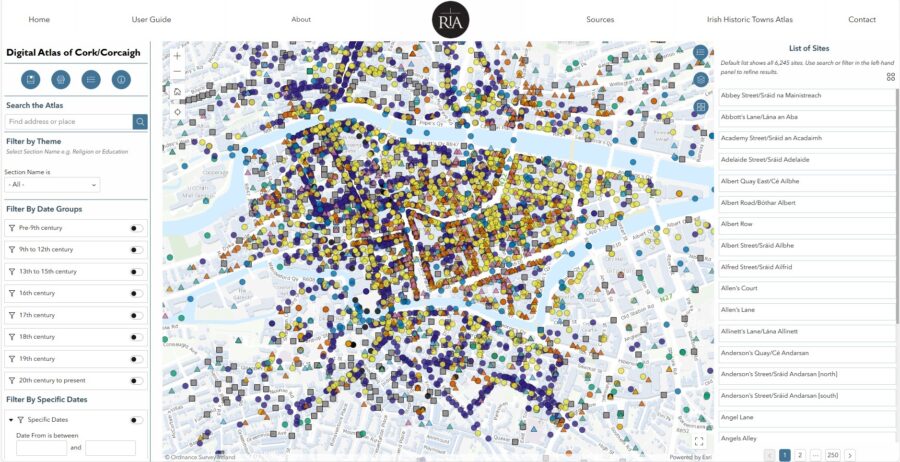
Kieran’s Our City, Our Town Article,
Cork Independent, 11 January 2024
The New Digital Atlas of Cork
They say the best way to get to know a city is to walk it – and in these early January days it is an ideal time. In Cork you can get lost in narrow streets, marvel at old cobbled lane ways, photograph old street corners, look up beyond the modern shopfronts, gaze at clues from the past, be enthused and at the same time disgusted by a view, smile at interested locals, engage in the forgotten and the remembered, search and connect for something of oneself, thirst in the sense of story-telling – in essence feel the DNA of the place.
Giving walking tours for over 30 years has allowed me to bring people on a journey into that soul but also receive feedback on the wider contexts of what visitors and locals have seen elsewhere. Cork is a city packed with historic gems all waiting to be discovered at every street corner.
Cork has a soul, which is packed full of ambition and heart. Cork’s former historic networks and contacts are reflected in its the physical urban fabric – its bricks, street layout and decaying timber wharfs. Inspired by other cities with similar trading partners, it forged its own unique take on port architecture.
So the new Digital Atlas of Cork/ Corcaigh is very welcome. It is one of a series of digital atlases created by the Irish Historic Towns Atlas team (the others are Derry, Dungarvan and Galway). The Digital Atlas of Cork/Corcaigh is an initiative of the Digital Working Group of the Irish Historic Towns Atlas research programme. The project has been led by Sarah Gearty (Royal Irish Academy) and Rachel Murphy (University of Limerick), with Mani Morse (Dublin City University) as Digital Manager.
The Digital Atlas of Cork/Corcaigh is a free online interactive map that invites you to discover the built heritage of Cork City in a new way where 6,245 features of the city’s history from AD 623 to 1900 are mapped. The atlas includes descriptions of over 800 streets, including their names in Irish and English as well as historical variants.
Users can browse the digital atlas or search for a specific site in the city. They can also select and view features associated with specific time periods, from medieval times to the present day. Most notably, it maps out Cork’s earlier historical sites especially around South and North Main Street and its Viking age history and Anglo Norman history.
Each historical feature is represented by a coloured symbol, each feature has been categorized into one of eleven different themes such as entertainment, manufacturing, religion and transport. When a user clicks on a feature, key information about it is displayed in a pop-up box.
A specially commissioned historical map depicts each individual house and plot during the mid-nineteenth century (1842). This is just one of a number of layered maps that may be switched on and off to show how the city developed over the centuries.
Other layers include Ordnance Survey maps — a present-day plan of the city, as well as historic maps showing Cork pre-Great Famine and at the turn of the twentieth century. Additional map layers will be released over the coming months, providing access for the first time to digitised town plans by the Ordnance Survey (1842) and Valuation Office (1852–64).
A downloadable user guide has been created to accompany the resource, to allow anyone to explore the Digital Atlas with further education and project work in mind. The project has been part funded by the Heritage Council Stewardship Fund 2023. It has been supported by partners Cork City Council, the Digital Repository of Ireland, the National Archives of Ireland and Táilte Éireann.
The Digital Atlas is remarkable with over 6,000 entries. It is a tremendous new resource for all the people of Cork and will no doubt instil a sense of pride in local communities, through its use in schools and libraries. In particular, the research and further reading aspect of the atlas will be a great source for anyone with an interest in the history and development of Cork City. This innovative project from the Royal Irish Academy will make the valuable research of the Irish Historic Towns Atlas series available to a wider and more varied audience than heretofore.
The atlas will contribute immensely to the work of Cork City Council and the wider professional community in Cork particularly those working in archives, museums, education, planning, architecture and conservation. Ciara Brett, City Archaeologist, Cork City Council noted of the Digital Atlas:
“The Digital Atlas, when utilised with the forthcoming printed Atlas, will be a great benefit to the study of the changing urban environment and will provide practical assistance in the preparation and implementation of planning policy and development management in the City. The IHTA Cork/Corcaigh volume in digital format will add to the existing corpus of published material and will, I believe, encourage future research and study that will enhance our understanding and appreciation of our city”.
The Digital Atlas of Cork/Corcaigh is based on research carried out for Irish Historic Towns Atlas, no. 31, Cork/Corcaigh by Howard B Clarke and Máire Ní Laoi, which will be published by the Royal Irish Academy in print in May 2024.
Based at the Royal Irish Academy, the Irish Historic Towns Atlas research programme traces the topographical development of towns, cities and suburbs through its atlas and ancillary publications, annual seminars and special exhibitions. It is part of a wider international scheme that covers nineteen countries. The Irish programme is considered a leader in the development of digital atlases of this kind.
For more log onto www.ria.ie/digital-atlas-corkcorcaigh
Caption:
1235a. Screen grab of the Digital Atlas of Cork.